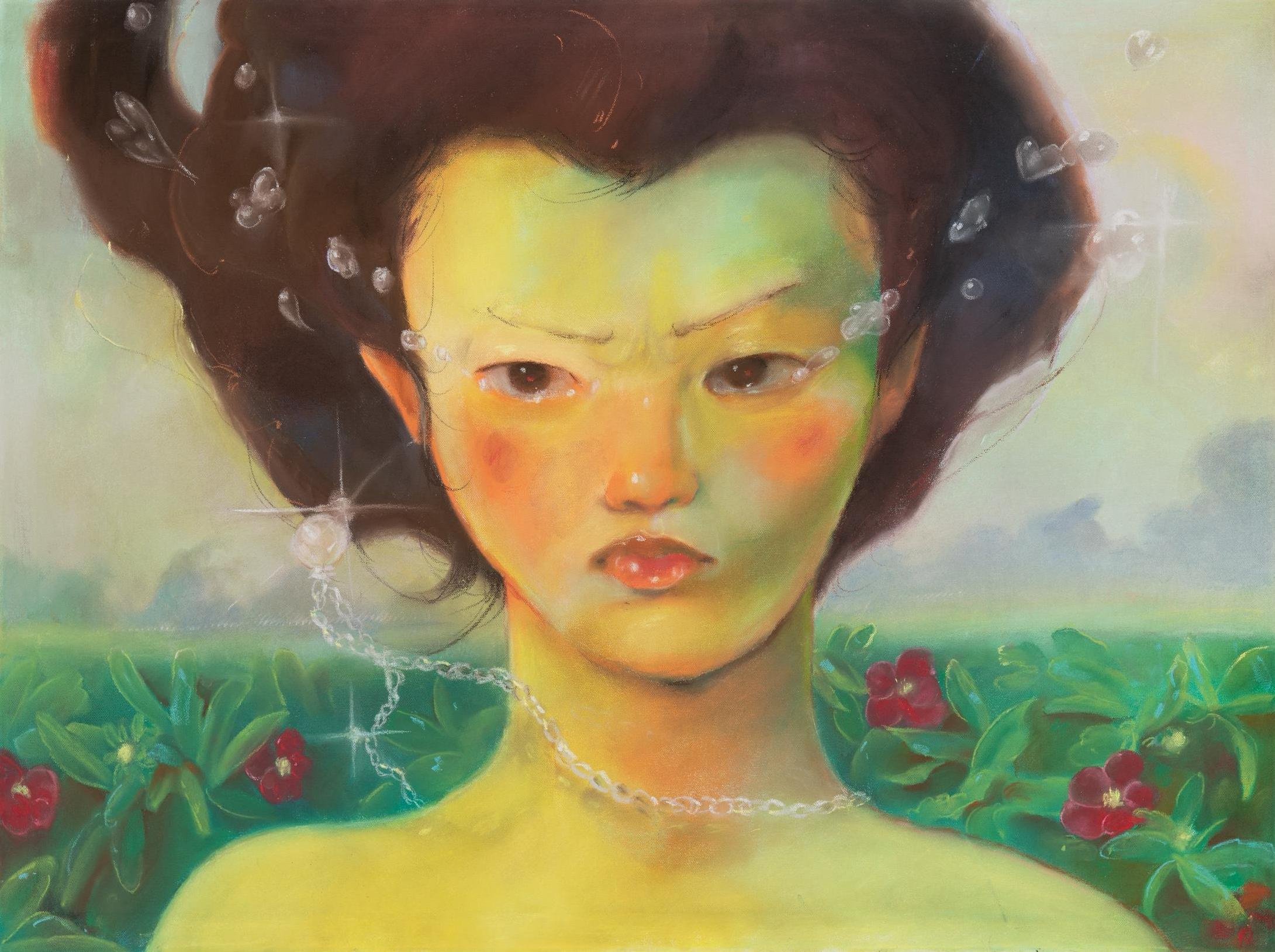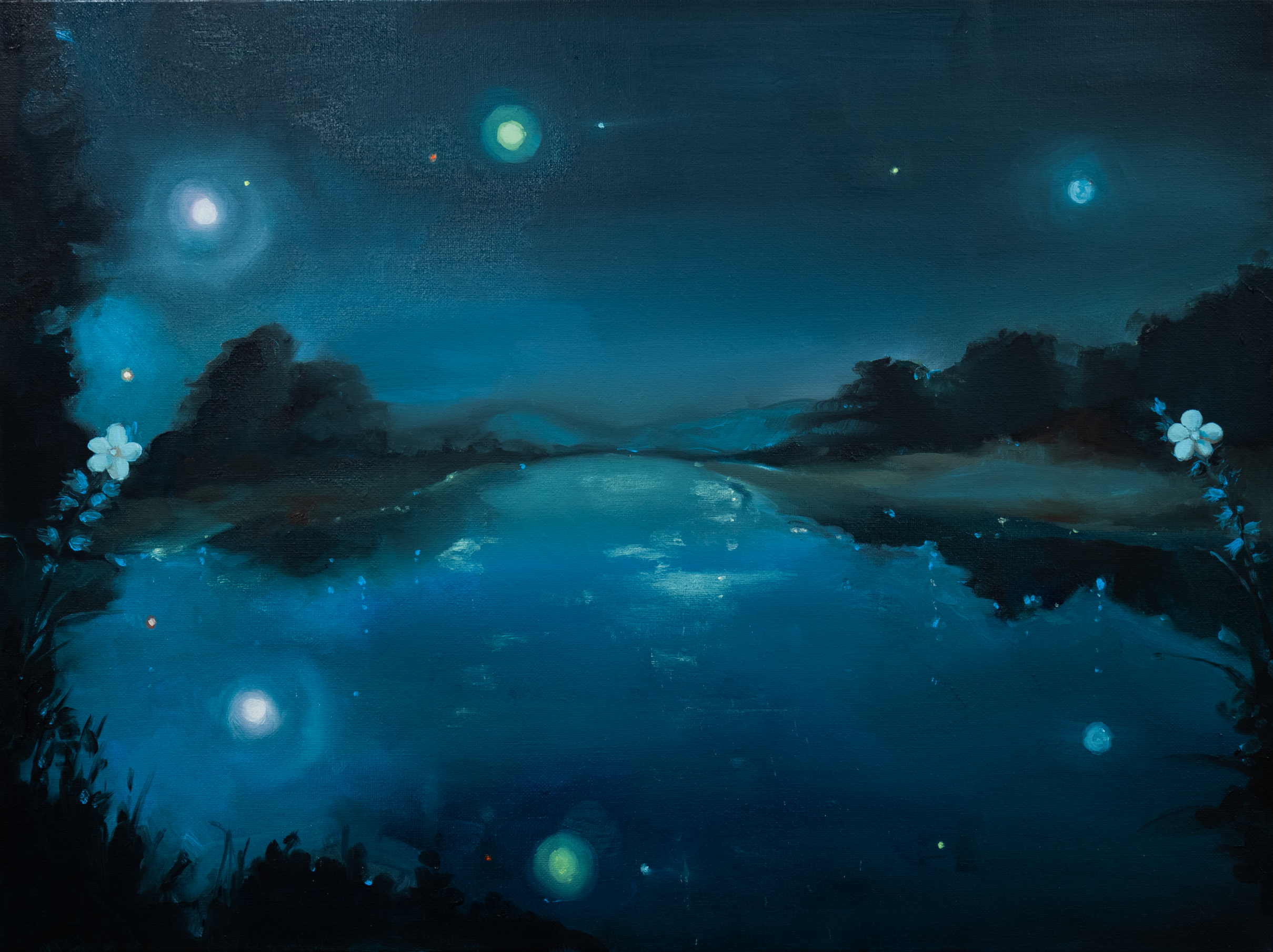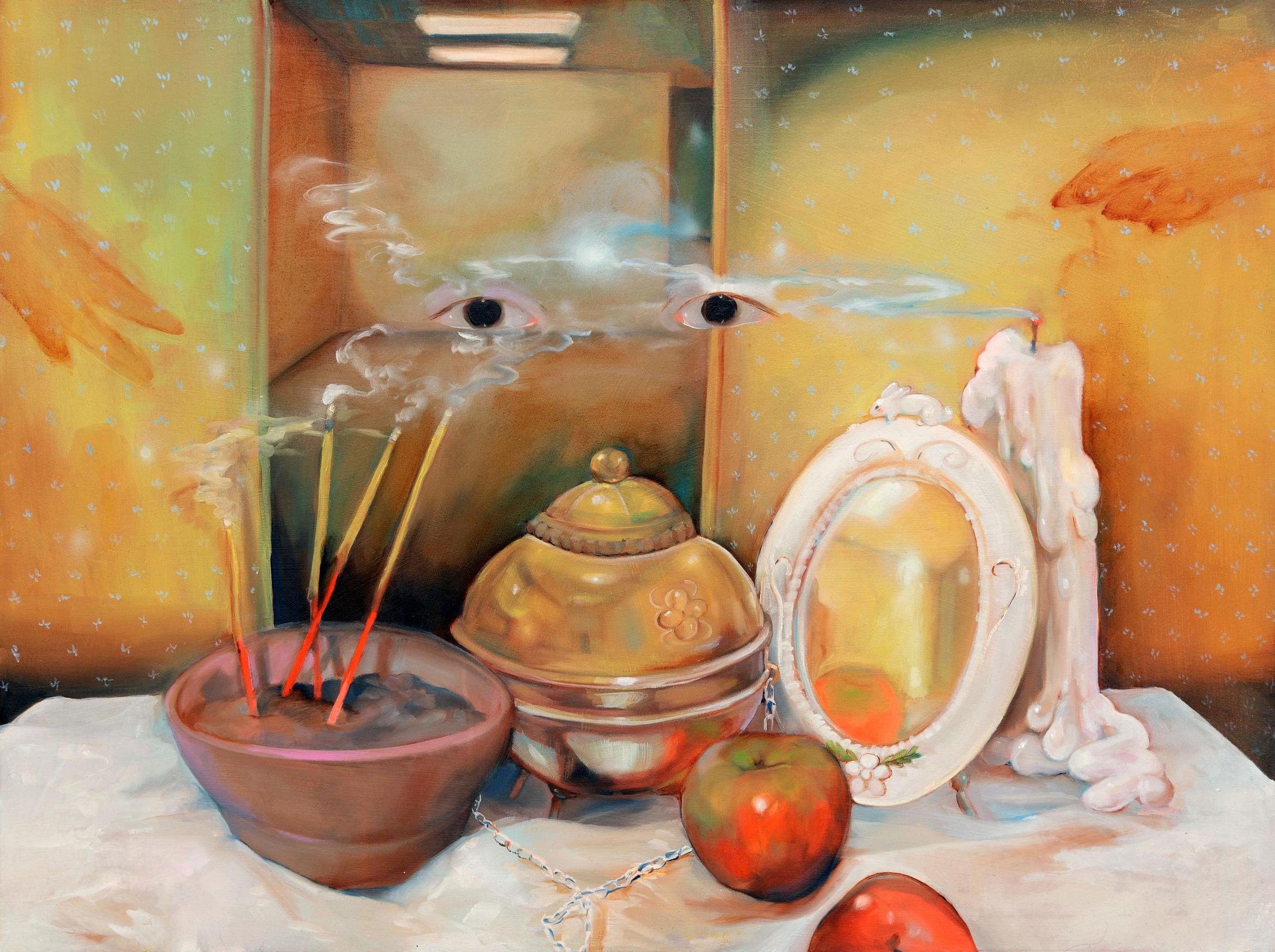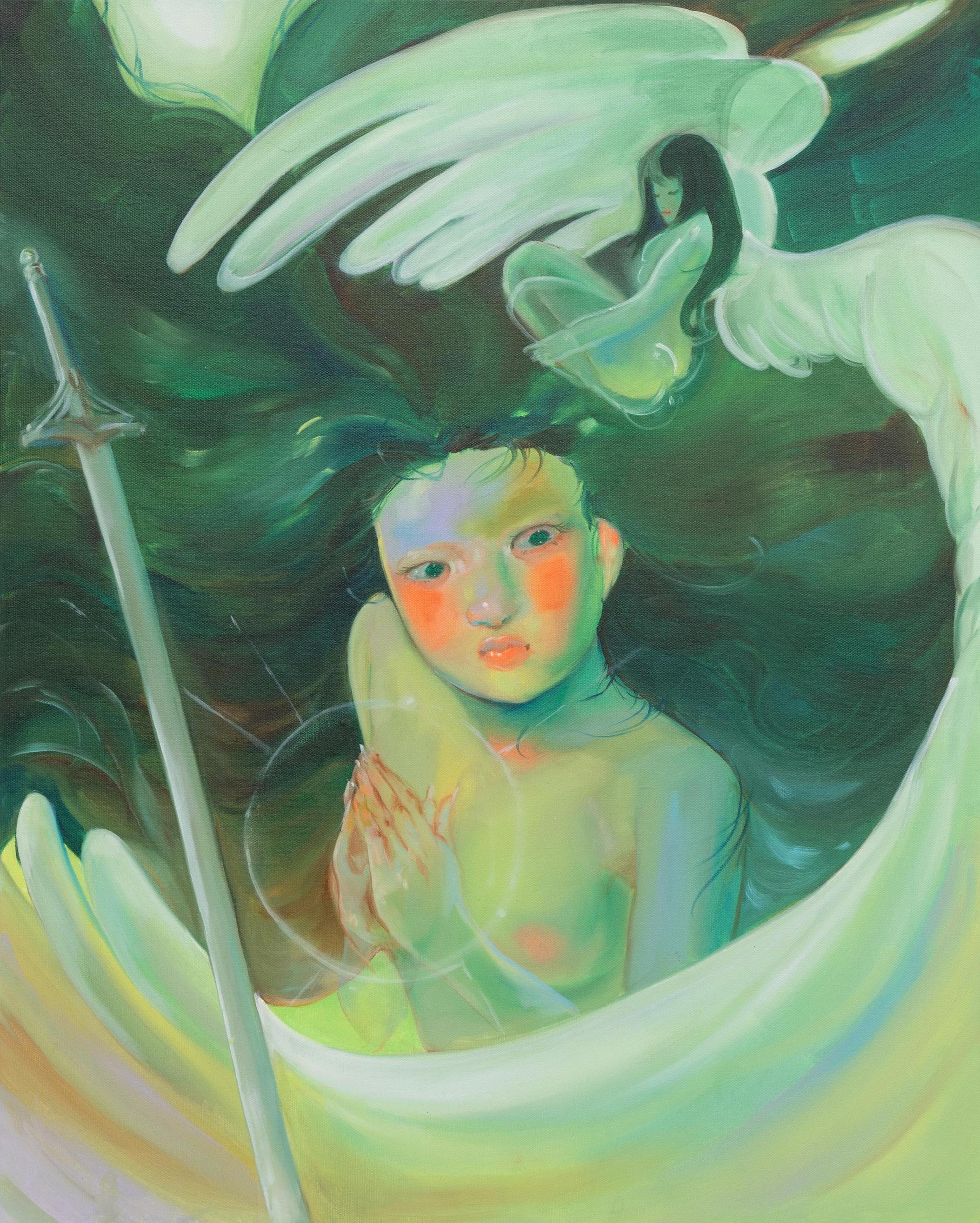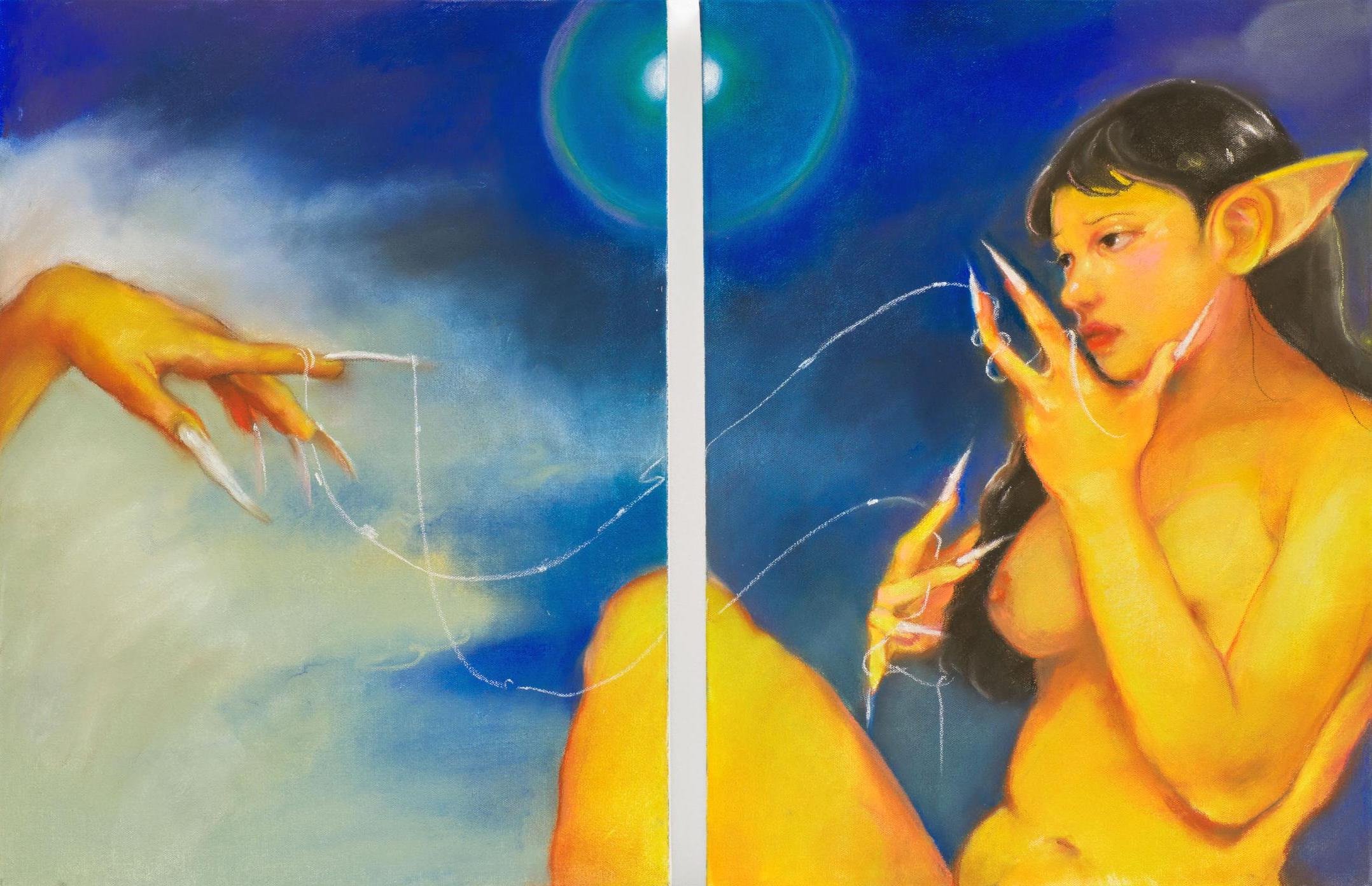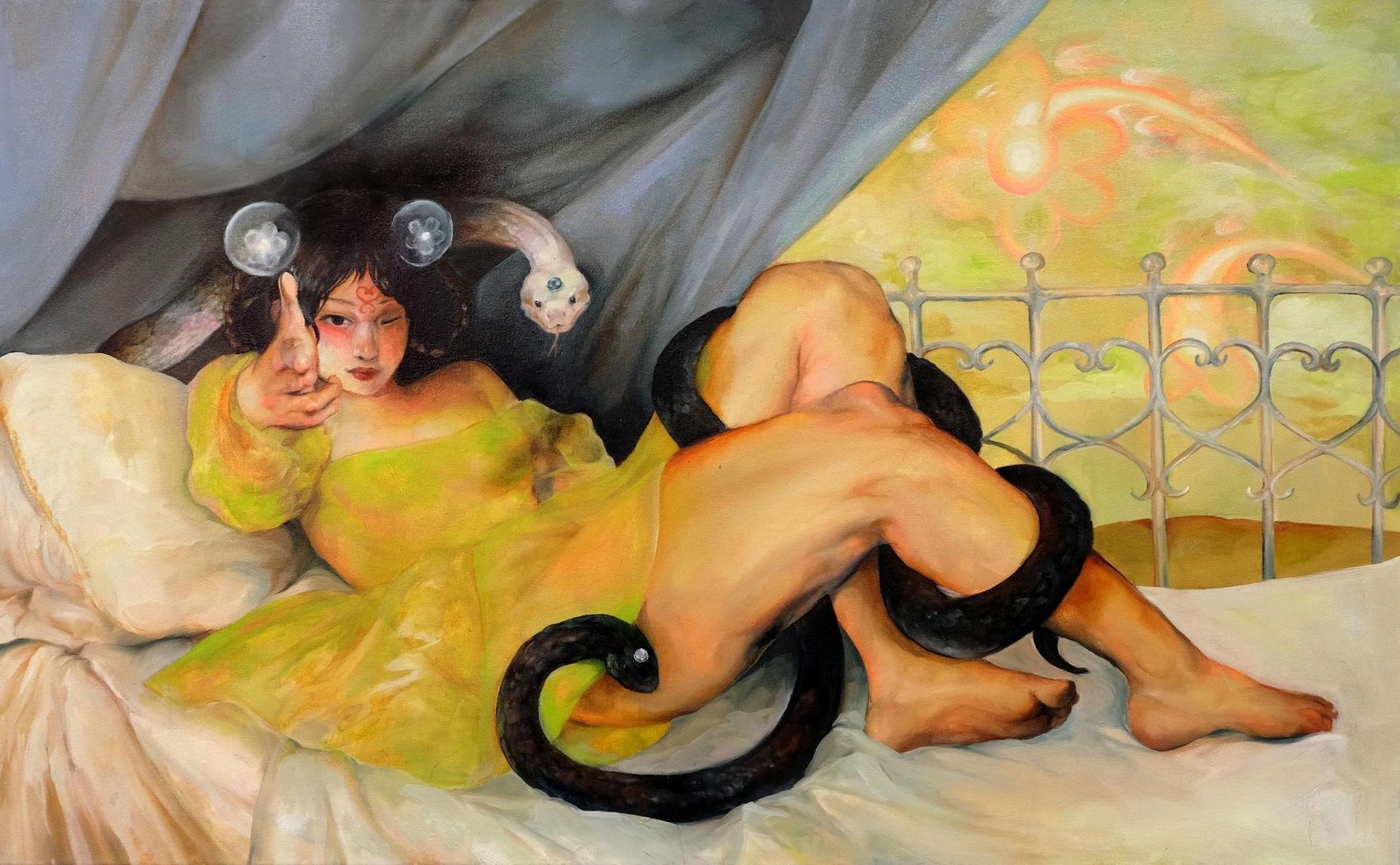Fantasy, Heroines, and New Realms
Housewife (or After “She, The Ultimate Weapon”) by Augustina Wang
A brand new interview with New York-based painter Augustina Wang 🗽 Wang’s fantastical work explores power, trauma, and her Asian femme identity, scroll down for more 🧚🏼
Addy: Augustina, thanks so much for joining me! How did you first develop an interest in painting?
Augustina: As a child, I was always interested in art. My mom signed me up for weekend classes and I learned a lot of fundamentals there, but for the bulk of my life, my love of art was fueled by the internet and online communities. I used to love sharing “work” (random doodles and fanart) on Tumblr and Deviantart, just as much as I loved visiting the museum or looking through art books.
I Saw Her Come From the Water by Augustina Wang
Addy: Yes, I used to love scrolling on Tumblr. Your work explores Asian femme identity through lore and world-building. How does world-building empower you?
Augustina: For me, I grew up specifically as a first-generation Asian American, meaning my parents were both immigrants to the US and my brother and I were the first generation to be born US citizens. A lot of my family history, because I have been westernised, feels foreign to me— even though I speak Chinese, I look Chinese, and I lived in Flushing (a mainly Chinese community in NYC), there’s a distinct disconnect between me and the rest of the tree. I grasp at tenuous branches to piece together what my mother’s life was like, and what her mother’s life was like, and I recognise there’s a certain “lore” among the women of our family that I personally could relate to. It feels as though certain joys and moreover, certain traumas, were almost fated for Asian women, no matter what nationality.
Deliverance by Augustina Wang
However, these musings are from an older, more knowledgeable self. As a child, my Chinese-ness and my girl-ness manifested as a deep insecurity. I was hyper-aware of being Chinese, being different, whenever I moved past Flushing (and even in Flushing, I still felt a tad different for being first-generation and functionally illiterate in Chinese). It was also deeply uncomfortable learning how to be a girl, and what rules or boxes I needed to live in to be accepted by not just society, but by Chinese society. There wasn’t a place where, as a child, I truly felt myself without boundaries except on the internet— making stories and building worlds where I roleplayed as someone else, someone more confident, not living with the baggage Earth and family thrust upon me. I find it empowering.
Addy: Totally, it can feel so isolating growing up as a first-generation kid and trying to figure out where you fit in. Whereas online, you can sort of be whoever you want. Can you describe your creative process, from the initial concept to the finished painting?
Augustina: I feel like I’m at my most creative right before I sleep. I get all sorts of strange ideas and epiphanies on what I want my next project to be, or a sort of flash of inspiration that suddenly makes life make sense. It’s just a few minutes of this creative state, so I try to really meditate and remember what my half-awake state comes up with; if it’s really good I’ll sleepily get up and write down a note. It’s a fine line though— there are nights where I really push these sessions and I end up staying up the whole night.
Celestial Alignment by Augustina Wang
Conception starts there. I do a sketch, sometimes pencil, sometimes digital, of just a quick value study or colour study. I hunt down references and collect them in a cache, which is usually my personal Miro board or Tumblr. Then when it feels good, I get a canvas and start painting. I usually just use gesso, but I’ve been liking oil ground too. From there, I do a very old-school technique of burnt sienna underpainting with layers of colours and glazes on top.
Addy: That’s so interesting! I love that most of your ideas manifest at night. Your work delves into both personal and primordial traumas. Can you describe the symbolism or imagery you use to convey these often complex experiences?
Augustina: I work with my own personal syntax of symbols, many of them obscure and inaccessible to the outsider. This lets me have my true, personal ownership and knowledge of a painting before it’s shown to everyone else.
Some of the experiences I’ve had are horrible to recount and only palatable as a symbol, yet when they become symbolised in my paintings viewers can behold them without needing to know. I find this exchange fascinating— it adds to the lore and world-building aspects that I am interested in but expands on it in a metacontextual way. Eventually, when there is an entire mythology of my paintings, some scholar in the future may find some threads...
Shadow Visions in a Yellow-Skinned Room by Augustina Wang
In terms of primordial trauma, one that I personally think about a lot is pregnancy. Indeed, childbirth can be beautiful, but the process of it is at least physically traumatic, if not emotional. I was fixated on fertility as a symbol when the Supreme Court nearly blanket banned abortions, and every day there were horror stories of those repercussions. At the time (and right now), I had a birth-control implant in my arm. It is a cyborgian add-on, it protects but it also alters the body. My complex feelings culminated in a painting of a girl with an implant, a harkening on my own personal history/sexual trauma, as well as the primordial trauma of the notion that certain bodies must be governed and punished.
go to, heaven by Augustina Wang
Addy: Pregnancy is such a life-changing experience, and so many women suffer in silence, that’s why it’s important to have these conversations. Are there any artists or art movements that have had a significant influence on your practice?
Augustina: I think the “academic” answer would be the Pre-Raphaelites of the 1800s, as well as the women Surrealists of the 1930s. I find these two threads of art movements not just interesting historically (Pre-Raphaelites in their rejection of academic art conventions; women Surrealists in putting a feminine perspective in a very misogynistic art movement) but because their aesthetics informed more modern modes of storytelling via video games. For example, many roleplaying games feature knights and princesses, as well as artwork inspired by the Pre-Raphaelites in order to costume up a believable fantasy world; meanwhile, Pre-Raphaelites were costuming up their own fantasy worlds with knights, elves, and princesses because they were borrowing stories and aesthetics from the 1400s. There’s a level of fakery and mythology present, and as an artist who’s inspired by both academia and everyday consumable art (namely video games, anime, manga) it’s important to acknowledge the commonalities and throughlines.
Other specific artists I’m interested in include various manga/comic artists like: Hirohito Araki (creator of “Jojo’s Bizarre Adventure”), Yoshitaka Amano, and CLAMP. I also admire several painters like Gustave Moreau, Nadia Waheed, and Ivan Rabuzin.
Poiesis by Augustina Wang
Addy: So true, I’ve never considered the Pre-Raphaelite influences across video games. You’ve mentioned that your work is also inspired by your mum, can you elaborate on how your art reflects the intergenerational and cultural aspects of your identity and hers?
Poet by Augustina Wang
Augustina: I’ve definitely struggled with bridging the cultural and intergenerational gap between me and my mother. My father passed when I was a child, so I was raised by a single mother. She was definitely tough on me, and there were times when I harbored resentment, but as I grew older I realised that she was incredibly strong. She would tell me stories here and there, and I would have to piece together her own mythos. But there was a consistent thread of survival and trauma, not unlike my own. It sort of made me wonder if all women, their daughters and sisters, go through the same thing— if bearing the history of misogyny was a duty that every femme was just sort of forced into.
Silk Trap by Augustina Wang
After the 2020 lockdown, I was incredibly lonely. It genuinely felt like I had no home— AAPI hate crimes skyrocketed in the US, even in diverse cities like New York. Meanwhile, there was so much bad press circulating in China at that time (and even now) as politicians fanned the flames. At that time, I really wanted to make a world where Asian women could rest, heal, and find a place to belong, devoid again of the burden of Earth, heritage, or family. I really leaned into escapism, rejecting reality and embracing fantasy in terms of my artwork.
Addy: Sometimes it feels like, as women, we’re all just experiencing cycles of trauma with no way out, but you turned your trauma into something beautiful and there’s so much power in that. Which painting are you the most proud of?
Augustina: That’s a funny question! I really do think of my paintings as children, so the right answer is none. But also, even I know that’s not actually true— the truth is they fall in and out of favour. Sometimes I look back at an old painting and try to chase the person I was when I made it. Sometimes I think the best painting is the one I’m working on right now. Sometimes I hate all of them and think of them as a cross to bear. It depends on the day.
Unbound Spirit (Death, Bliss, and After) by Augustina Wang
Addy: I love that answer, it just depends on how you’re feeling. How do you navigate the fine line between escapism and using your art as a source of healing?
Augustina: I don’t think there is a fine line at all. In my mind, escapism is a form of roleplay, and most people, especially marginalised people, subconsciously try on different personalities or identities every day. To “escape” is to lean into this roleplay and self-medicate. I think if someone makes art, they are inherently drawing upon this experience. Therefore, there is no boundary, there is only a circle.
Addy: Beautiful. What role does experimentation play in your art practice?
Augustina: I take my art practice seriously, though I also consider “play” a form of work. I think everyday experiences especially inform artistic inspiration. I’m not afraid to mix strange artistic sources together to make my own personal language, even if they’re subtle. For example, I’ve been inspired by fanart and fanfiction for a while, but I think absolutely nobody could tell that unless I’ve explained my own personal history and inspiration— and I think that’s good.
Snake Goddess by Augustina Wang
Addy: Definitely, and how do you see your art contributing to a larger conversation about representation, agency, and power?
Augustina: I really hope that younger generations see my work and my story and resonate with it; especially younger femmes or queer folk who made their home and identity on the internet. When I became an art-schooled certified “artist”, there was a push to forget about my roots as just a weird girl who drew anime fanart on her school desk, and I didn’t want to forget about her or think I was too good for her. I suspect the coming generations of artists will have the same struggles, and as institutions move in the wake of artists, I hope they keep these artists in mind too.
Addy: Yes, and I think your work strikes a chord with a lot of people, young and old. So at the end of interviews, I like to do something called a rapid fire round 🔥 here we go! Still life or landscapes?
Augustina: Still life.
Addy: Sculpture or pottery?
Augustina: Pottery.
Addy: Collage or mosaic?
Augustina: Mosaic.
Addy: Miniature art or large-scale installations?
Augustina: Miniature art.
Evolve Scales, Gemini by Augustina Wang
Addy: Utopia or dystopia?
Augustina: Utopia (duh!!)
Addy: Wildflowers or autumn leaves?
Augustina: Wildflowers.
Addy: Yess <3 Classic mythology or contemporary folklore?
Augustina: Classic mythology (but not by much).
Addy: Waterfalls or desert landscapes?
Augustina: Waterfalls.
Addy: Leather or denim jackets?
Augustina: Denim jackets.
Addy: Last song you listened to?
Augustina: Savage Garden - I Want You.
Addy: Amazing, can’t wait to listen to it. Augustina, thank you so much for joining me!
For more from Augustina, check out her website here!



